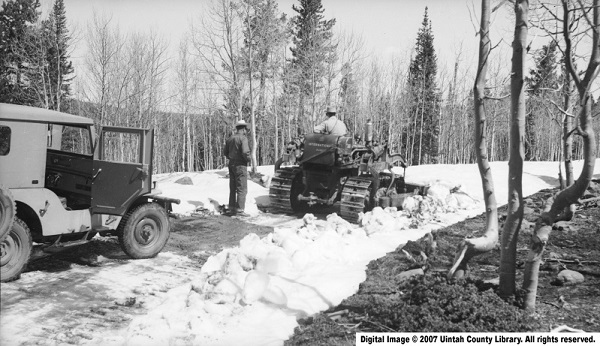Dublin Core
Title
Description
Think about your daily travel routines. What would you do without well-maintained roads, air-conditioning, or ways to entertain the kids?
Did you know that 86% of American commuters drive cars to work and spend an average 50 minutes each day on the road? Today we cover distances with relative ease on well-maintained roads. But this wasn’t always the case.
In the past, roads were often the worst part of car trips, particularly in rain or snow. Until the first motorized snowplows hit the market in the 1920s, work crews used horse-drawn plows and shoveled cities out by hand. Snow removal in rural areas proved especially daunting. In 1933 the Utah Road Commission had only 156 snowplows, while traveling road crews and local volunteers did the rest. Otto Kesler, who ranched out at Cove Fort, routinely patrolled his stretch of highway between Fillmore and Beaver, often opening the fort to stranded motorists.
Hot weather was just as bad. In 1936 the Millard County Chronicle reported on the invention of air-conditioned railroad cars, stating that, “Travelers no longer need fear the excessive heat of a cross-country train ride.” Air-conditioning was a luxury car owners would not enjoy until the 1960s and ‘70s. Until then, drivers managed the heat by hanging water bags off the front of their cars. Wind passing through the bags kept the water cool for drinking and helped overheated radiators. Similarly, box coolers attached to car windows worked by chilling air as it passed through a damp pad inside the box.
What about passengers? When Miriam and Emil Whitesides traveled from Kaysville to California in 1927, their two-year-old daughter entertained herself by swinging on the car’s rooftop slats. In the 1950s and ’60s, parents were advised to pack plenty of books and games for their children on long trips. Other gadgets like the Trav-L-Tot Hammock transformed the back seat into a playpen where children could roll around. Today we buckle kids into safety seats, entertaining them with portable electronic devices.
How might people 100 years from now make their road trips? Jetsons, here we come!
Creator
Rebecca Andersen for Utah Humanities © 2014
Source
Image: Snow Plow Equipment, 1955. Tractor plowing snow on a mountain road, possibly near Dry Fork. For many Utah towns in the early 1900s, snow removal meant few snowplows and a lot of volunteer labor. Courtesy of Uintah County Library Regional History Center.
_______________
See “Snow Removal,” National Snow & Ice Data Center, accessed https://nsidc.org/cryosphere/snow/removal.html; “Utah Spends Huge Sums to Combat Winter” Salt Lake Telegram, February 8, 1933; LeGrande Kesler Davies, “Cove Creek Ranch Fort: The Kesler Era,” 19, Typescript, January 1969 (copy in possession of Rebecca Andersen); “No More Hot Trains for the West,” Millard County Chronicle July 23, 1936; “Car Air Conditioning: Is This Your Year?” Popular Science July 1963, 82-84; “Roughing it the Easy Way,” Popular Mechanics May 1941, 676; Raymond Arsenault, “The End of the Long Hot Summer: The Air Conditioner and Southern Culture,” The Journal of Southern History Vol. 50, No. 4 (Nov. 1984), 597-628; American Fact Finder, Commuting Characteristics by Sex, 2008-2012 American Community Survey 5-Year Estimates, accessed http://factfinder2.census.gov/faces/tableservices/jsf/pages/productview.xhtml?src=CF; Susan Sessions Rugh, Are We There Yet? The Golden Age of American Family Vacations (Lawrence: University Press of Kansas, 2008), 28-29; Miriam Renstrom Whitesides, “My Book of Remembrance,” 62, Typescript, October 1976 (copy in possession of Rebecca Andersen).
Publisher
The Beehive Archive is a production of Utah Humanities. Find sources and the whole collection of past episodes at www.utahhumanities.org
Date
2014-09-19

